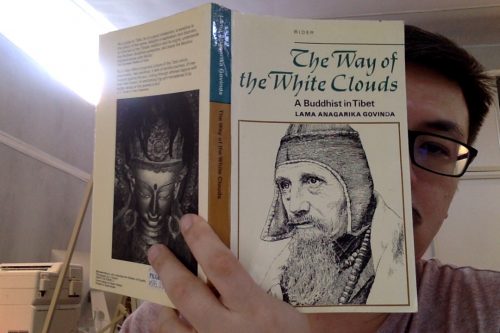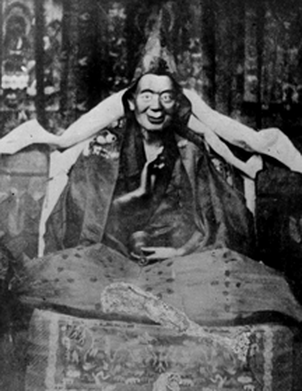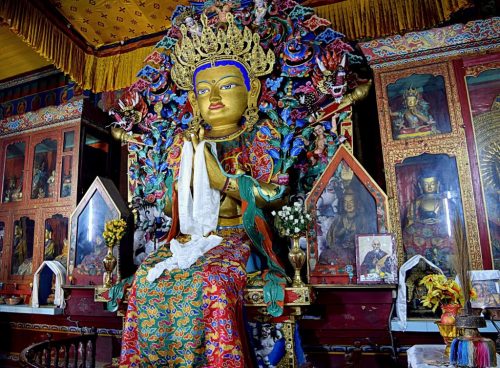The Way of the White Clouds
17 Jul
 I have been wanting to blog about a recent reading and sharing of ‘The Way of the White Clouds’ by Lama Anagarika Govinda. The book tells the story of the author’s meeting with the great hermit-lama Domo Geshe Rinpoche. Rinpoche asked me to read the chapter, ‘A Lama’s Vision’ and we were all soon transported to another place and time and had audience with Domo Geshe Rinpoche, whom Rinpoche said was the rare emanation of Lama Tsongkhapa. We often hear lamas to be incarnation of Atisha, like Kyabje Trijang Rinpoche and so forth but rarely do we ever hear of an emanation of Lama Tsongkhapa.
I have been wanting to blog about a recent reading and sharing of ‘The Way of the White Clouds’ by Lama Anagarika Govinda. The book tells the story of the author’s meeting with the great hermit-lama Domo Geshe Rinpoche. Rinpoche asked me to read the chapter, ‘A Lama’s Vision’ and we were all soon transported to another place and time and had audience with Domo Geshe Rinpoche, whom Rinpoche said was the rare emanation of Lama Tsongkhapa. We often hear lamas to be incarnation of Atisha, like Kyabje Trijang Rinpoche and so forth but rarely do we ever hear of an emanation of Lama Tsongkhapa.
The first half of the book reveals the hermit to be living up in the mountains of Southern Tibet while engaging in retreat for 12 years. The landscape is forbidding as food was scarce at that time and only a hermit with special yogic powers would be able to live under such harsh conditions. Rinpoche told me to stop in order to savour the passage. He said he had always wanted to do the same- enter into intense retreats on his yidam and develop attainments by becoming one with the yidam. As rinpoche talks, his eyes closed and his hands clasped in fervent delight.
After a few moments, he told me to continue. A herder discovers the hermit and due to his altruistic Bodhisattva vows, he was compelled to return to the world of men. Then the narrative moves on towards the miraculous vision manifested by the Lama at Chorten Nyima. This is a famous incident in Domo Geshe Rinpoche’s life in which he manifested a vision of the Buddhas that countless people present was able to receive parts of the vision of the Buddhas, which depended on their mental receptivity. Rinpoche had said that by the power of Domo Geshe Rinpoche’s incredible realization of primordial wisdom, he was able to extend that realization to his audience for a short moment. Thus, he was able to give them a taste of the bliss of egolessness.

An old photo of Domo Geshe Rinpoche’s mummified remains dressed in his robes of a high lama.
Then, I was reading this passage…
“Domo Geshe, however, did not content himself with the success of his work at Dungkar. He erected statues of Maitreya in many other places and made the followers of the Buddha-Dharma conscious of the fact that it was not sufficient to bask in the glories of the past, but that one must take active part in the shaping of the future, and thus make it possible for the coming Buddha to appear in this world by preparing our minds for his reception.”
… when rinpoche stopped me to ask what does that mean.
I was dumbfounded. I attempted to answer but rinpoche was very quick to shift to Pastor Niral for a better answer. Pastor Niral explained that Domo Geshe Rinpoche built many statues of Maitreya in order to prepare the coming of Maitreya, the future Buddha instead of relying solely on the glories of past Buddhas alone. Rinpoche said that the first part of the answer was good and he went on to explain that many people these days appear to practice the Dharma taught by previous Buddhas but achieve no realization and so, Domo Geshe Rinpoche sought to plant as much blessings of Maitreya in these people as possible so they would take rebirth as direct students of Maitreya and gain final release. Rinpoche also said that he sees the wisdom of Domo Geshe Rinpoche but he does not build big statue of Maitreya as he does but does the same thing with Dorje Shugden.

The beautiful Maitreya statue of Ghoom Monastery was commissioned by Domo Geshe Rinpoche.





“Nearly all written biographical information about Geshe Ngawang Kalsang, who later became known as Domo Geshe Rinpoche, was lost in Tibet. However there does exist the lineage prayer composed by Kyabje Trijang Dorje Chang; biographical material mentioned by the Western disciple Lama Govinda in his book The Way of the White Clouds; and many diverse oral sources.”
Domo Geshe Rinpoche’s disciple Lama Anagarika Govinda recorded in The Way of the White Clouds that Geshe Rinpoche “detested any kind of hero-worship and did not want his person made into an object of veneration.” On the day that Domo Geshe Rinpoche accepted him as a disciple his Guru told him:
“If you wish me to be your Guru, do not look upon my person as the Guru, because every human personality has its shortcomings, and so long as we are engaged in observing the imperfections of others we deprive ourselves of the opportunities of learning from them. Remember that every being carries within itself the spark of Buddahood (bodhicitta), but as long as we concentrate on other people’s faults we deprive ourselves of the light that in various degrees shines out from our fellow-beings ….The greatest among men were those who recognized the divine qualities in their fellow-beings and were always ready to respect even the lowliest among them.
As long as we regard ourselves superior to other or look down upon the world, we cannot make any real progress. As soon, however, as we understand that we live in exactly that world which we deserve, we shall recognize the faults of others as our own —though they may appear in different form. It is our own karma that we live in this “imperfect” world, which in the ultimate sense is our own creation. This is the only attitude which can help us to overcome our difficulties, because it replaces fruitless negation by an impulse towards self-perfection, which not only makes us worthy of a better world but partners in its creation.”
Source:
http://www.domogesherinpoche.org/domo-geshe-rinpoche-ngawang-kalsang.html